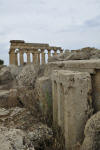Doric Sicily
While I was in Sicily to photograph Arab Norman art and Architecture, I also found time to make a brief visit to several of the numerous ancient sites on the island including the famous Temple of Concord in the Valley of the Temples at Agrigento, Selinunte, and Segesta.
|
Gallery
|
Valley of the Temples, Agrigento
Agrigento was founded in 581 BC by colonists from Gela. It was called Akragas. Within a century the population grew to 200,000, and included many slaves. The most perfectly preserved among the ensemble of ancient temples in the Valley of the Temples is the one dedicated to Concord, 5th C. BC. Its remarkable state of preservation is due in large part to its conversion to a Christian church in the 4th century. In 1748 it was restored to its classical appearance.
Selinunte
The dramatic site overlooking the Mediterranean Sea was settled in the 7th centyru BC by colonists from Megara Hyblae. It became a flourishing commercial center that supported high culture in spite of rivalries with Segesta and Mozia that often resulted in wars. Shaken by earthquakes over the millennia, it is now totally ruined, a jumbled heap of fluted drums that once stood nearly 100 feet tall, making Temple G, 540-480 BC, dedicated to Apollo, among the largest such structures in antiquity. Temple E, 490- 480 BC, partially rebuilt in the 1960s, is believed to have been dedicated to Hera. Temple F, 560-530 BC, now totally ruined, was dedicated to Athena.
Segesta
According to legend, the ancient capital of the Elymians was established in these lush rolling hills overlooking the sea by exiles from Troy. In spite of a constant condition of war between Segesta and Selinunte and repeated plundering of the town, the magnificent temple survived. The 6 X 14 peripteral Greek-Sicilian temple at Segesta was begun circa 450 BC but was never completed, probably due to the occupation of the city by the Cartthaginians in 409 BC. It is unknown to which deity this temple was to be dedicated. Later the city was incorporated into the Roman Empire and many changes occurred in the urban center.
Surrounding countryside































